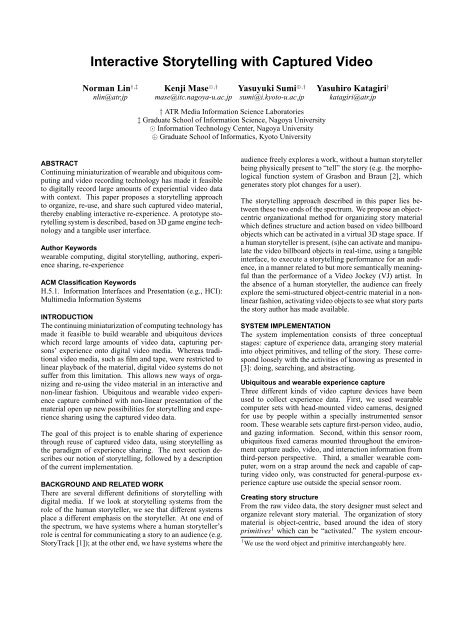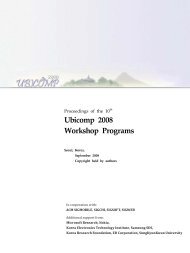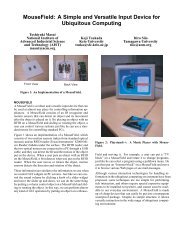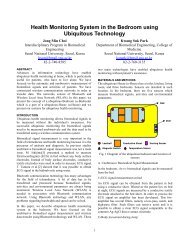Interactive Storytelling with Captured Video - ResearchGate
Interactive Storytelling with Captured Video - ResearchGate
Interactive Storytelling with Captured Video - ResearchGate
You also want an ePaper? Increase the reach of your titles
YUMPU automatically turns print PDFs into web optimized ePapers that Google loves.
<strong>Interactive</strong> <strong>Storytelling</strong> <strong>with</strong> <strong>Captured</strong> <strong>Video</strong><br />
Norman Lin †,‡<br />
nlin@atr.jp<br />
Kenji Mase ⊙,†<br />
mase@itc.nagoya-u.ac.jp<br />
Yasuyuki Sumi ⊕,†<br />
sumi@i.kyoto-u.ac.jp<br />
† ATR Media Information Science Laboratories<br />
‡ Graduate School of Information Science, Nagoya University<br />
⊙ Information Technology Center, Nagoya University<br />
⊕ Graduate School of Informatics, Kyoto University<br />
Yasuhiro Katagiri †<br />
katagiri@atr.jp<br />
ABSTRACT<br />
Continuing miniaturization of wearable and ubiquitous computing<br />
and video recording technology has made it feasible<br />
to digitally record large amounts of experiential video data<br />
<strong>with</strong> context. This paper proposes a storytelling approach<br />
to organize, re-use, and share such captured video material,<br />
thereby enabling interactive re-experience. A prototype storytelling<br />
system is described, based on 3D game engine technology<br />
and a tangible user interface.<br />
Author Keywords<br />
wearable computing, digital storytelling, authoring, experience<br />
sharing, re-experience<br />
ACM Classification Keywords<br />
H.5.1. Information Interfaces and Presentation (e.g., HCI):<br />
Multimedia Information Systems<br />
INTRODUCTION<br />
The continuing miniaturization of computing technology has<br />
made it feasible to build wearable and ubiquitous devices<br />
which record large amounts of video data, capturing persons’<br />
experience onto digital video media. Whereas traditional<br />
video media, such as film and tape, were restricted to<br />
linear playback of the material, digital video systems do not<br />
suffer from this limitation. This allows new ways of organizing<br />
and re-using the video material in an interactive and<br />
non-linear fashion. Ubiquitous and wearable video experience<br />
capture combined <strong>with</strong> non-linear presentation of the<br />
material open up new possibilities for storytelling and experience<br />
sharing using the captured video data.<br />
The goal of this project is to enable sharing of experience<br />
through reuse of captured video data, using storytelling as<br />
the paradigm of experience sharing. The next section describes<br />
our notion of storytelling, followed by a description<br />
of the current implementation.<br />
BACKGROUND AND RELATED WORK<br />
There are several different definitions of storytelling <strong>with</strong><br />
digital media. If we look at storytelling systems from the<br />
role of the human storyteller, we see that different systems<br />
place a different emphasis on the storyteller. At one end of<br />
the spectrum, we have systems where a human storyteller’s<br />
role is central for communicating a story to an audience (e.g.<br />
StoryTrack [1]); at the other end, we have systems where the<br />
audience freely explores a work, <strong>with</strong>out a human storyteller<br />
being physically present to “tell” the story (e.g. the morphological<br />
function system of Grasbon and Braun [2], which<br />
generates story plot changes for a user).<br />
The storytelling approach described in this paper lies between<br />
these two ends of the spectrum. We propose an objectcentric<br />
organizational method for organizing story material<br />
which defines structure and action based on video billboard<br />
objects which can be activated in a virtual 3D stage space. If<br />
a human storyteller is present, (s)he can activate and manipulate<br />
the video billboard objects in real-time, using a tangible<br />
interface, to execute a storytelling performance for an audience,<br />
in a manner related to but more semantically meaningful<br />
than the performance of a <strong>Video</strong> Jockey (VJ) artist. In<br />
the absence of a human storyteller, the audience can freely<br />
explore the semi-structured object-centric material in a nonlinear<br />
fashion, activating video objects to see what story parts<br />
the story author has made available.<br />
SYSTEM IMPLEMENTATION<br />
The system implementation consists of three conceptual<br />
stages: capture of experience data, arranging story material<br />
into object primitives, and telling of the story. These correspond<br />
loosely <strong>with</strong> the activities of knowing as presented in<br />
[3]: doing, searching, and abstracting.<br />
Ubiquitous and wearable experience capture<br />
Three different kinds of video capture devices have been<br />
used to collect experience data. First, we used wearable<br />
computer sets <strong>with</strong> head-mounted video cameras, designed<br />
for use by people <strong>with</strong>in a specially instrumented sensor<br />
room. These wearable sets capture first-person video, audio,<br />
and gazing information. Second, <strong>with</strong>in this sensor room,<br />
ubiquitous fixed cameras mounted throughout the environment<br />
capture audio, video, and interaction information from<br />
third-person perspective. Third, a smaller wearable computer,<br />
worn on a strap around the neck and capable of capturing<br />
video only, was constructed for general-purpose experience<br />
capture use outside the special sensor room.<br />
Creating story structure<br />
From the raw video data, the story designer must select and<br />
organize relevant story material. The organization of story<br />
material is object-centric, based around the idea of story<br />
primitives 1 which can be “activated.” The system encour-<br />
1 We use the word object and primitive interchangeably here.
Capture while doing<br />
Capture while doing<br />
Browse and extract<br />
story primitives<br />
searching<br />
doing<br />
KNOWLEDGE<br />
abstracting<br />
Perform story<br />
Story structure<br />
Figure 1: Conceptual components of the system for story<br />
construction and story telling using video data captured<br />
from ubiquitous and wearable capture devices. Knowledge<br />
cycle adapted from [3].<br />
ages the story designer to look for objects or primitives whose<br />
video history, as captured by the video capture device, can<br />
communicate relevant information about the story. The story<br />
designer assigns to each primitive a number of actions; each<br />
action represents one segment of the object’s video history<br />
which is a relevant visual element in the story. The story designer<br />
then creates one or many sets of relevant video primitives.<br />
Each set can be thought of as a stage set in a play; it is<br />
a collection of active objects, upon which actions can be invoked<br />
and <strong>with</strong> which the storyteller interacts in order to tell<br />
the story. The sets are temporally arranged into a sequence,<br />
which serves as a time-line for the intended story flow; a set<br />
can be used more than once in a sequence. Sets (each containing<br />
story primitives) and their temporal sequence comprise<br />
a story episode, which is intended to serve as an externalized,<br />
story-based representation of an episodic memory.<br />
Telling stories and re-experiencing material<br />
To tell stories, a human storyteller uses this system as an interactive<br />
performance tool to represent the visual aspects of<br />
the story. The storyteller proceeds through the sets in the<br />
storyboard by selecting a set <strong>with</strong> the mouse in the application<br />
GUI. Each story primitive in a set is displayed as a<br />
video billboard in a 3D game engine. An augmented reality<br />
tangible user interface maps each story primitive to a tangible<br />
artifact, using optical video tracking. Physical placement<br />
of the tangible artifact in space determines the virtual placement<br />
of the video billboard in the 3D game engine, allowing<br />
real-time, natural physical positioning of story elements.<br />
The storyteller activates actions on video primitives, using a<br />
gestural activation interface, in order to visually tell the visual<br />
and spatial parts of the story, while simultaneously and<br />
as appropriate telling a spoken story about what is being activated<br />
on screen (similar to [1]).<br />
Through the use of videos containing text , narration can be<br />
built into the story primitives and can be activated like any<br />
other action. This allows meaningful yet non-linear exploration<br />
of the story space by an audience even in the absence<br />
of a storyteller.<br />
CONCLUSIONS AND FUTURE WORK<br />
We described a storytelling system using video data captured<br />
from ubiquitous and wearable sensors which allows objectcentric,<br />
non-linear story organization and exploration. Future<br />
extensions include automatic analysis of captured in-<br />
Figure 2: <strong>Storytelling</strong> interface allowing spatial placement<br />
and activation of story primitives, represented as<br />
video billboards in a 3D game engine and controlled by<br />
a tangible user interface. Left: we see three primitives:<br />
elevators, a cup of tea, and a standing human character.<br />
Right: the “walk” action has been invoked on the human<br />
object, triggering playback of the associated video.<br />
teraction data combined <strong>with</strong> templates to suggest a starting<br />
story structure and story primitives. Also planned is<br />
the recording of a storytelling performance and the use of<br />
the recorded performance as a source of story material. By<br />
treating re-experience (storytelling) as an experiential process<br />
and not simply as a playback of material, we hope that<br />
we can, to some degree, unify the concepts of experience<br />
and re-experience. This would enable evolution and cyclic<br />
refinement of experiential knowledge, allow comparison of<br />
captured experience and re-experience behaviors, and could<br />
reveal insights into the structures of compelling stories, of<br />
memory, and of human experience. We envision a future<br />
where experience capture equipment is ubiquitous; enabling<br />
experiential sharing and re-experiencing of this ubiquitously<br />
captured material in story environments will be a compelling<br />
and enriching application.<br />
ACKNOWLEDGEMENTS<br />
We thank our colleagues at ATR for valuable contributions<br />
and help. This work was supported in part by the National<br />
Institute of Information and Communications Technology.<br />
REFERENCES<br />
1. BALABANOVIC, M., CHU, L. L., AND WOLFF, G. J.<br />
<strong>Storytelling</strong> <strong>with</strong> digital photographs. In Proceedings of<br />
the SIGCHI conference on Human factors in computing<br />
systems (New York, NY USA, 2000), ACM Press,<br />
pp. 564 – 571.<br />
2. GRASBON, D., AND BRAUN, N. A morphological<br />
approach to interactive storytelling. In Proceedings:<br />
cast01 // living in mixed realities, special issue of<br />
netzspannung.org/journal, The magazine for media<br />
production and inter-media research. (2001),<br />
M. Fleischmann and W. Strauss, Eds.<br />
3. SMOLIAR, S. W., AND BAKER, J. <strong>Storytelling</strong>,<br />
jamming, and all that jazz: Knowledge creation in the<br />
world of new media. In Proceedings of the 32nd Annual<br />
Hawaii International Conference on Systems Sciences,<br />
HICSS-32 (Los Alamitos, CA, USA, 1999), IEEE<br />
Computer Society.






